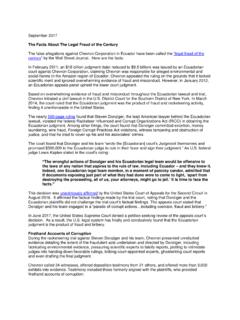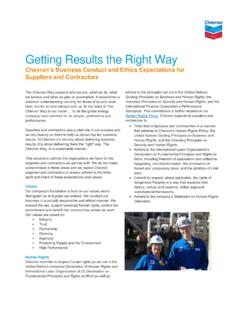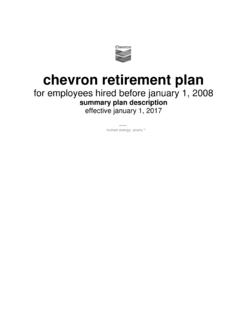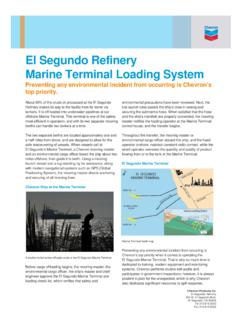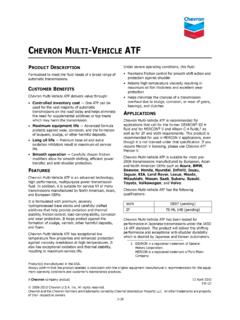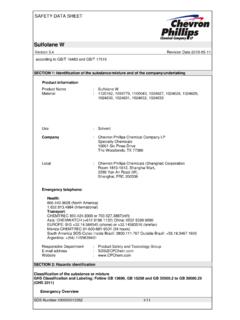Transcription of Aviation Technical Aviation Fuels - Business Desk
1 Recycled/Recyclable paperMS-9891 (11/14) chevron Products Company6001 Bollinger Canyon Road San Ramon, CA 94583 chevron Products Company is a division of a wholly owned subsidiary of chevron 2007 chevron Inc. All rights and the Caltex, chevron and Texaco hallmarks are federally registered trademarks of chevron Intellectual Property 1114-099612 Recycled/recyclable paperAviation Fuels Technical ReviewAviation Fuels Technical Review | chevron Products CompanyPlease note: This information is accurate as of fall 2004. It may be superseded by new regulations, specifications, or advances in fuel or engine , edited, and designed by employees and contractors of chevron .
2 Greg Hemighaus, Tracy Boval, John Bacha, Fred Barnes, Matt Franklin, Lew Gibbs, Nancy Hogue, Jacqueline Jones, David Lesnini, John Lind and Jack authors would like to express their sincere thanks to Steve Casper (United Airlines), Cesar Gonzalez (consultant), Oren Hadaller (Boeing), Rick Moffett (Textron Lycoming), Roger Organ (Caltex), Jerry Scott (UVair), Stan Seto (GE Aircraft Engines), Rick Waite (Velcon Filters), and Ron Wilkinson (Electrosystems) for reviewing a draft version of this publication and making many helpful suggestions. Any remaining errors or omissions are the sole responsibility of the Fuels Technical Review (FTR-3) 2007 chevron Corporation.
3 All rights Introduction ..i1 Aviation Turbine Fuel Introduction .. 1 Types of FuelFuel Consumption2 Aviation Turbine Fuel Performance .. 3 Performance Properties CleanlinessSafety Properties Emissions3 Aviation Turbine FuelSpecifications and Test Method ..14 Specifications Test Methods4 Aviation Turbine Fuel Composition ..24 Base FuelProperty/Composition Relationships Chemistry of Jet Fuel InstabilityWater in Jet FuelAdditives5 Aviation Turbine Fuel Refining ..33 Raw MaterialRefining ProcessesThe Modern Refinery6 Aviation Turbine Engines ..38 Principle of OperationEngine TypesCombustion in the Engine7 Aviation Gasoline Introduction.
4 43 Grades of FuelFuel Consumption8 Aviation Gasoline Performance .. 45 Performance Properties CleanlinessSafety Properties9 Aviation Gasoline Specifications and Test Methods .. 54 Specifications Future Fuels Test Methods10 Aviation Gasoline Composition .. 63 CompositionProperty/Composition Relationships Additives11 Aviation Gasoline Refining .. 66 AlkylationAvgas Blending12 Aircraft Piston Engines .. 68 Internal Combustion EnginesEngine DevelopmentA Aviation Fuel Distribution and Handling ..74 Fuel Distribution SystemReceiving Fuel at AirportsContamination and CleanupQuality ControlB About ChemistrySources of More Information.
5 89 Abbreviations .. 90 Table of Contents NotesiMan has long been captivated by the possibility of flight. From Icarus wings to DaVinci s flyingmachines to lighter-than-air balloons, inventive minds worked to turn the dream into a what was lacking was a means of propulsion. This finally became available in the early yearsof the 20th century with the development of the internal combustion engine. This engine provideda compact and portable source of power that allowed man to overcome the pull of early aircraft engines were similar to those used in automobiles and burned the same need for increased power led to the development of specialized engines and Aviation gasolines(avgas) tailored to their requirements.
6 In the 1940s, the turbine engine emerged as the answer tothe quest for still more power. In a replay ofavgas development, kerosine the fuel used in thefirst aircraft turbine engines was eventually replaced by specialized Aviation turbine Fuels (jet Fuels ).In the last 90 years, Aviation has grown from a novelty to an essential, even defining, element ofmodern society. It enables people and goods to move around the globe in hours, rather than theweeks or months that used to be is powered by petroleum Fuels . This is not an accident; the choice is based on petro-leum s recognized advantages. Liquid Fuels have higher energy contents per unit volume thangases, and are easier to handle and distribute than solids.
7 Among liquids, liquid hydrocarbonsoffer the best combination of energy content, availability, and Review covers the performance, properties, specifications, composition, and manufacture ofaviation Fuels , both turbine fuel and Aviation gasoline. Since engine and fuel are interdependentcomponents of a single system, it also touches on engine basics. And it addresses the specialprecautions incorporated in the distribution system to ensure quality and cleanliness as fuel ismoved from refinery to IntroductionTXT_213103A 9/30/06 7:24 AM Page iidfasdfasefdasdfasdfTXT_213103A 9/30/06 7:24 AM Page iiiJet propulsion can be traced back to the 1st century when an Egyptian, Hero, is credited withinventing a toy that used jets of steam to spin a sphere.
8 Sixteen centuries later, Leonardo da Vincisketched a device that used a flux of hot gas to do mechanical work. By the 17th century, inventorswere beginning to develop simple turbine systems to operate development of a turbine engine for aircraft began independently in Germany and Britainin the 1930s. In Germany, Hans von Ohain designed the engine that powered the first jet flight in1939. Germany deployed the jet-powered Messerschmitt 262 late in World Wa r Britain, Frank Whittle obtained a patent for a turbine engine in 1930. An aircraft powered byan engine he designed first flew in 1941. The first British jet fighter, the Gloster Meteor, also flewlate in World Wa r of FuelIlluminating kerosine, produced for wick lamps, was used to fuel the first turbine engines.
9 Sincethe engines were thought to be relatively insensitive to fuel properties, kerosine was chosenmainly because of availability; the war effort required every drop of World Wa r II, the Air Force started using wide-cut fuel, which, essentially, is a hydro-carbon mixture spanning the gasoline and kerosine boiling ranges. Again, the choice was drivenby considerations of availability: It was assumed that a wide-cut fuel would be available in largervolumes than either gasoline or kerosine alone, especially in time of , compared to a kerosine-type fuel, wide-cut jet fuel was found to have operationaldisadvantages due to its higher volatility: Greater losses due to evaporation at high altitudes.
10 Greater risk of fire during handling on the ground. Crashes of planes fueled with wide-cut fuel were less the Air Force started to change back to kerosine-type fuel in the 1970s and has essentiallycompleted the process of converting from wide-cut (JP-4) to kerosine-type (JP-8) Navy has used a high flashpoint kerosine-type fuel (JP-5) on aircraft carriers becauseof safety considerations since the early 1950s. See Figure for a list of military jet the commercial jet industry was developing in the 1950s, kerosine-type fuel was chosenas having the best combinations of properties. Wide-cut jet fuel (Jet B) still is used in some partsof Canada and Alaska because it is suited to cold climates.

